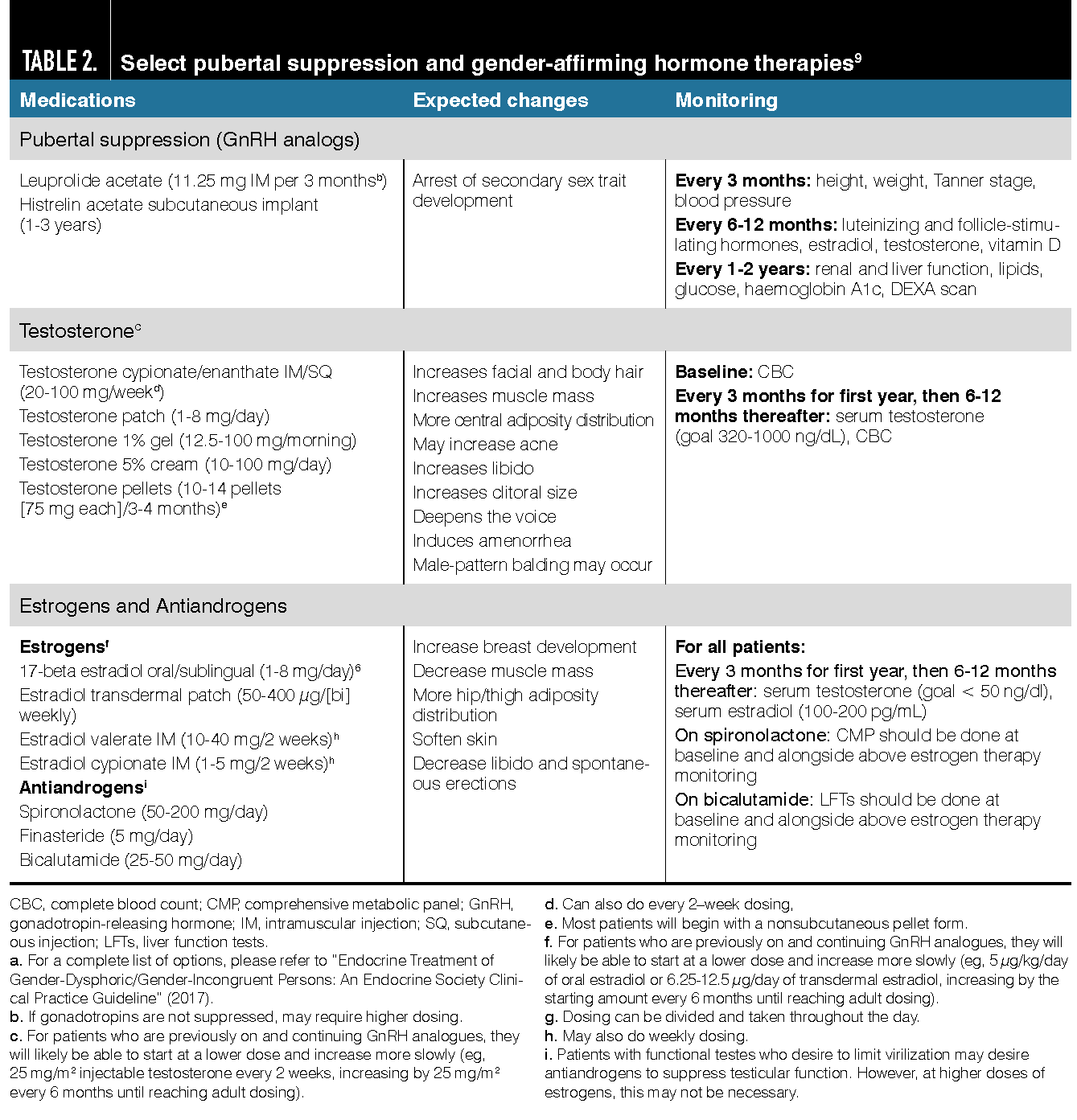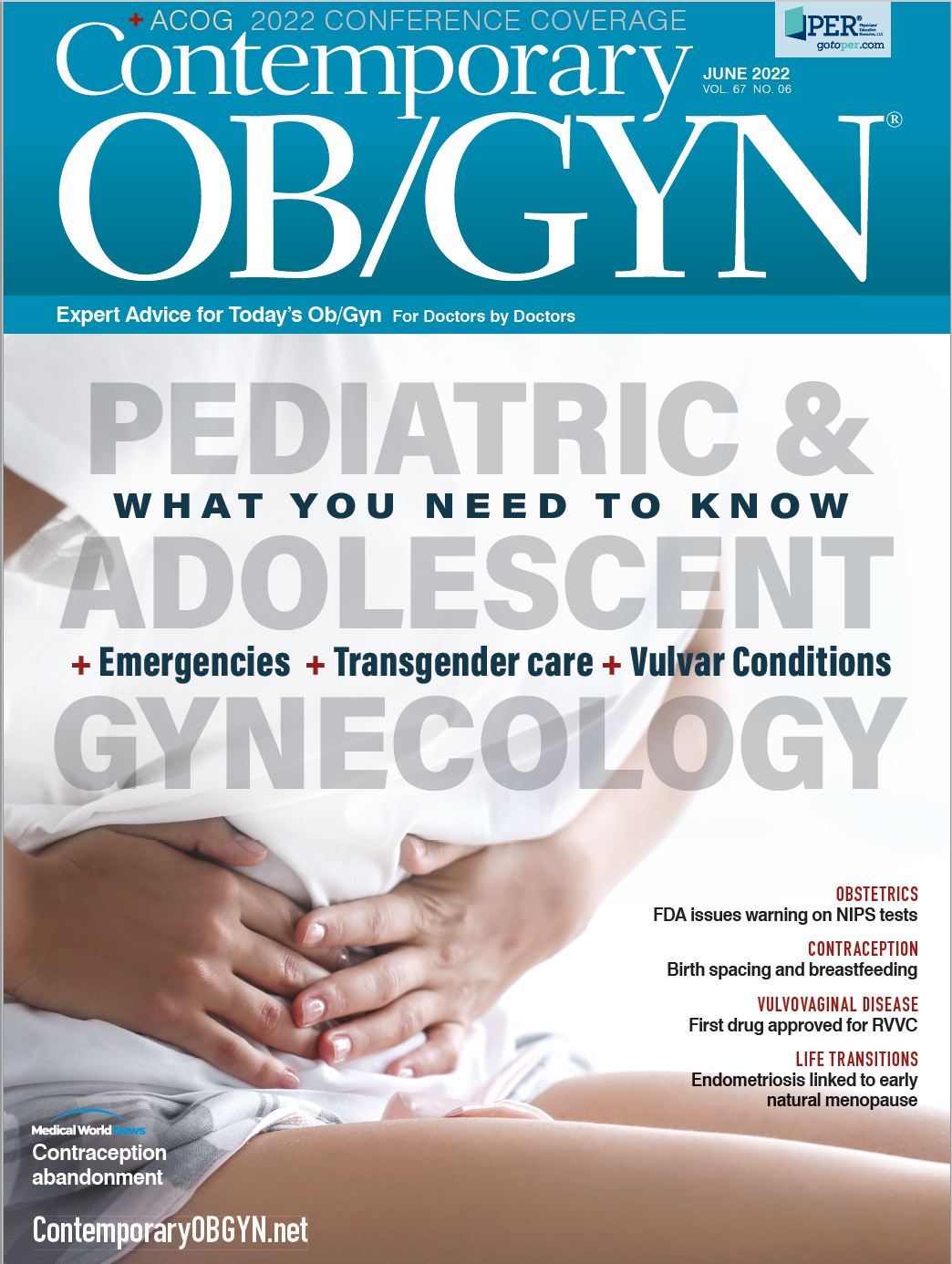View as PDFTransgender and nonbinary (TGNB) adolescents are those whose gender identity differs from their sex assigned at birth (Figure). In the United States, 2% of adolescents identify as TGNB.1 Given the prevalence, almost any clinician who sees adolescent patients will see TGNB patients. It is essential to be prepared to provide competent care.
TGNB adolescents are facing growing inequities, including health care disparities. These disparities are often rooted in medical disenfranchisement, exemplified by stigma and discrimination both inside and outside the medical system.2
Almost one-third of TGNB individuals have had 1 or more negative experiences in health care related to their gender identity, including the inability to find a knowledgeable provider, being discriminated against in medical settings, or being refused necessary treatment because of their gender identity.2 Increasing legal barriers also threaten the well-being of TGNB adolescents, and a growing number of states are seeking to curtail access to gender-affirming care (GAC).3 At a time when TGNB identities are under siege, every clinician and clinical space should be safe, welcoming, and supportive.
Creating a welcoming clinical environment
Patients must feel welcomed in clinical settings, and the care team should employ several things to establish inclusive spaces for gender-diverse patients (Table 1), including the following:
- Ensure clinical environments have posters, flyers, or other reading materials that are reflective of all genders. Visible emblems, such as TGNB flags and pronoun pins, can be intentional symbols of safety and inclusion for TGNB adolescents and their families.
- Reevaluate clinic titles (eg, women’s health) for accuracy to ensure they are reflective of all patient population(s) receiving care.4
- Ensure inclusive bathrooms for diverse gender identities are available.
- Have space on intake forms and medical records for the patient’s name-in-use, legal names (if different from name-in-use), and pronouns.5
- Ensure name-in-use and pronouns are relayed with every transfer of care. All adolescents should be asked about name-in-use and pronouns in private, as caregivers may not be privy to how a TGNB adolescent identifies. Clinicians should never discuss a patient’s gender or pronouns with caregivers without
their consent. - Train all staff (including front-of-house and associated departments) in gender-inclusive practices.
When establishing a patient’s medical history and performing a physical exam, providers should consider a few things that are relevant for some TGNB adolescents. Some TGNB patients may undergo surgeries to align their bodies with their gender; clinicians should not assume current anatomy. Instead, an anatomic inventory that assesses current and past anatomy can be helpful.
Additionally, some adolescents may experience dysphoria or distress related to certain parts or functions of their body (eg, genitals, hair, and menses) that do not align with their gender.6,7 Clinicians should be sensitive to this and, when appropriate, ask patients whether there are nonanatomic terms they use to describe their body parts and how they work.
Providers should always mirror patients’ language when possible. If a patient experiences distress with a part of their body where an examination is indicated, clinicians should utilize a trauma-informed approach and engage in shared decision-making. This would include if, when, and how the exam will occur, as well as the potential use of support persons or alternative focus techniques (eg, headphones). Clinicians should prioritize noninvasive alternatives when available (eg, a pelvic ultrasound instead of a bimanual exam).
Gender-affirming therapies
In the care of TGNB adolescents, the most prevalent care provided is social affirmation. This can manifest as affirming the patient’s name, gender, and pronouns. Additionally, some patients may desire and benefit from cognitive, medical, or surgical gender-affirming therapies. Every TGNB individual’s gender embodiment goals are different, and clinicians should not assume every TGNB adolescent desire therapies.2
Gender-affirming mental health
Adolescence is a time when many people are exploring identity, including gender. Providers should affirm to patients that being gender diverse is not a mental health condition. However, some TGNB adolescents may experience dysphoria related to their gender, defined as an impairment in daily activities or functioning stemming from gender incongruence. This may be connected to pubertal changes or changes in peer relationships, among other things.
Some TGNB adolescents will benefit from affirming mental health support in navigating their identity.8 For TGNB minors who desire GAC, the current version of the “Endocrine Treatment of Gender-Dysphoric/Gender-Incongruent Persons: An Endocrine Society Clinical Practice Guideline” (2017) recommends the involvement of a trained behavioral health provider and a formal diagnosis of gender incongruence or gender dysphoria.9
For those who are not minors, clinicians comfortable in diagnosing gender incongruence do not need to have a separate mental health evaluation before GAC initiation. Additionally, not all TGNB adolescents will experience gender dysphoria and some will experience gender euphoria, instead.10 As such, behavioral health needs should be individual to the patient, their experiences, and goals.
Gender-affirming medical therapies
Gender-affirming medical therapies for TGNB adolescents include pubertal suppression medications and gender-affirming hormone therapies (GAHT). These have been shown to improve the mental health and quality of life of TGNB adolescents.9,11 Clinicians who are skilled in supporting this patient population are diverse, and obstetrician-gynecologists (ob-gyns) have many skills that allow them to learn and provide this care.12 Most medications reviewed below are off-label use.
Pubertal suppression
The goals of pubertal suppression therapies (Table 29)are to pause the development of secondary sex characteristics that may not align with a person’s gender identity.9 They also aid TGNB youth in having more time during adolescent development to identify the patient’s medical-related gender goals (eg, desire for GAHT or surgeries) and can be started as early as Tanner II.
These are generally safe, relatively reversible, and well-tolerated medications. The most commonly used are gonadotropin-releasing hormone (GnRH) analogues. They should not be used indefinitely in isolation, as sex steroids are beneficial for long-term health. Some patients will chose to continue them as they start GAHT to maintain endogenous supression. In this case, it is acceptable to continue pubertal suppression medications alongside GAHT. The added benefit for TGNB youth with pubertal suppression is limiting the development of secondary sex characteristics.
Otherwise, some TGNB individuals may later seek surgery to alleviate or reverse these developments, such as vocal cord thickening or breast development, functionally decreasing the need for future surgery. Once pubertal suppression is discontinued for youth who do not desire GAHT, natal puberty will continue to progress.
Menstrual suppression
Some TGNB adolescents with ovaries and uteri may utilize menstrual suppression for gender-affirming reasons (ie, due to dysphoria associated with menses) or nongender-affirming (eg, dysmenorrhea) reasons.13,14 Depending on their goals, menstrual suppressions can be used before, without, or in tandem with GAHT.
Although testosterone suppresses menses, up to one-quarter of TGNB adolescents may experience breakthrough bleeding, and thus may seek concomitant menstrual suppression.13 Menstrual suppression does not require a mental health clinician and can be prescribed by any clinician prescribing for nongender-affirming reasons.
In particular, some TGNB patients may be interested in danazol, which is a synthetic androgen progestin that produces mild virilizing effects at higher doses and successful menstrual suppression.15
Past medical history, patient preferences, and goals should influence the choice of method. Testosterone is also not an approved form of contraception, and those who engage in sexual activity and can achieve pregnancy should be counseled on contraceptive options, regardless of menstrual suppression goals.7
Gender-affirming hormone therapies
Testosterone
Testosterone is the mainstay therapy for patients who desire virilization.9 Testosterone acts to suppress endogenous estrogen and induce androgenic changes.Expected changes are noted in Table 2. Onset and maximal change may vary, depending on the individual, preparation, and dosing, but most achieve maximal effects by 2 years after initiation (Table 2).
Testosterone’s adverse effects include erythrocytosis, lipid profile changes, vaginal dryness, and possible mild elevation of transaminases.
Contraindications include active polycythemia and unstable coronary artery disease. Current evidence does not show an increased risk of reproductive cancers on testosterone.16-18 However, clinicians should engage in shared decision-making with families based on their specific history and the current evidence.
Estrogens and antiandrogens
For those seeking estrogenic effects, options typically include estrogens with or without the use of antiandrogens (Table 2).9 Antiandrogens are beneficial in suppressing the androgen effects for those with testes. Estrogen alone is sufficient for some patients, and others will not desire to suppress endogenous virilization.
Adverse effects of estrogen include headaches, breast tenderness, nausea, dry skin, increased appetite, weight gain, increased risk for venous thromboembolism (VTE), and estrogen-sensitive cancers later in life.
Prolactinemia may occur, which is asymptomatic in most cases, and routine monitoring is not necessary for those patients. Estrogen is contraindicated in active estrogen-sensitive cancers. Those who have other risks for thrombogenesis (eg, smoking or a history of VTE) should consider the less thrombogenic transdermal preparations.
Antiandrogen adverse effects, risks, and contraindications are specific to each medication. As discussed above, in pubertal suppression, GnRH analogues can also be used as antiandrogens.
Spironolactone, an aldosterone receptor antagonist and diuretic, is the most commonly used antiandrogen. Adverse effects include polydipsia, polyuria, hypotension, and hyperkalemia.
In addition, potassium levels must be monitored and hydration encouraged. Spironolactone is not a good option for TGNB adolescents who lack safe bathroom access, and it is contraindicated in patients with renal disease or hyperkalemia.
Finasteride, a 5α-reductase inhibitor, is another antiandrogen; it limits the conversion of testosterone to the potent dihydrotestosterone (DHT).
Bicalutamide is a nonsteroidal antiandrogen that selectively blocks receptor activation by androgens and DHT and may have estrogenlike effects. There are less data on bicalutamide’s use in TGNB patients. The main risk associated with bicalutamide is a rare risk of liver dysfunction, including fulminant hepatitis, and its use should be avoided in patients with hepatic disease.
Progestins
Some patients will desire to use progestins, although present data are inconclusive on their benefit. The goals of progestins are founded on anecdotal reports of improvements in breast development, mood, and libido.19 Providers should share decision-making with patients and determine whether they would like a trial of progestin. The most common forms used are micronized bioidentical progesterone (100-200 mg daily) and oral medroxyprogesterone acetate (2.5-10 mg daily).
Fertility, family building, gender-affirming medical therapies, and TGNB adolescents
TGNB individuals have diverse family-building goals, and those who want families may also desire genetically related children.20 Fertility preservation should never be considered a clinical requirement prior to initiating GAC. However, current guidelines recommend universally offering it to all patients before therapy initiation.9
Despite this, the data regarding GAC and fertility are rapidly changing, and as such, clinicians should counsel on the known and unknown risks and benefits of the specific therapies of interest to offer their patients the most up-to-date information about their options. For example, for TGNB adolescents who initiate GnRH analogues at the start of puberty, fertility may only be impacted should they subsequently progress to GAHT.
For these patients, the primary option for fertility preservation due to immature gametes is gonadal tissue preservation.20 For TGNB adolescents who are postpubertal with testes and desire estrogens, most data support that estrogens decrease fertility, and the mainstay of fertility preservation prior to therapy is cryopreservation of sperm.
Finally, a growing body of data suggest that for postpubertal TGNB adolescents who desire testosterone, it does not render ovaries and uteri infertile, as previously thought.21 These patients should be aware of the increasing reports of successful discontinuance of testosterone and preservation of oocytes and pregnancies.22,23 However, guidelines still recommend that if patients desire to minimize the impact of testosterone, then oocyte cryopreservation should be offered.
Gender-affirming surgical considerations in TGNB adolescents
Although a full review of gender-affirming surgeries (GASs) is beyond the scope of this paper, many clinicians who care for TGNB adolescents may have patients interested in these procedures.
GAS (Table 3) encompasses several procedures that help TGNB individuals align their bodies with their gender. Many of these are deferred until after the age of majority, which is 18 years in most municipalities. However, procedures such as chest masculinization are increasing in frequency in adolescents and have shown promising results.24
The World Professional Association Transgender Health Standards of Care are used as guidance for presurgical requirements in tandem to insurance companies and individual surgeon specific requirements.25 These can include minimum time on GAHT before surgery, mental health letters that support the procedure, or the need for hair removal.21
Patients should be counseled on fertility preservation before fertility-altering surgeries such as an orchiectomy, hysterectomy, metoidioplasty, or phalloplasty (which may require a hysterectomy). Of note, gender-affirming hysterectomies, including those done as prerequisites for metoidioplasty or phalloplasty, do not require oophorectomies.21
Conclusion
Key takeaways:
- Two percent of adolescents identify as transgender or gender nonbinary.
- Every patient’s gender goals are unique to them, and clinicians should always ask patients about their goals and not assume based on gender identity or expression.
- The most common gender-affirming care (GAC) a clinician will provide is welcoming and inclusive care, which includes respecting a patient’s gender, their name, and pronouns.
- Obstetrician-gynecologists are well positioned to provide other forms of GAC, including hormone therapy, gender-affirming hysterectomies, and postvaginoplasty care.
- Menstrual suppression can be offered to any patient with menstrual dysphoria, regardless of gender, menstrual patterns, or initiation of other GAC.
The experiences of TGNB adolescents are diverse, and ameliorating the disparities they face is vital. TGNB individuals represent 2% of adolescents in the United States; they have primary and may have specialty health care needs.
All patients deserve welcoming and affirming care, which every ob-gyn can provide. Learning to deliver aspects of this care can significantly increase access to this necessary field. In an era when many municipalities are seeking to curtail the rights of TGNB adolescents and limit their access to essential care, it is imperative now more than ever that ob-gyns expand their clinical services to provide care for this population.
References
Johns MM, Lowry R, Andrzejewski J, et al. Transgender identity and experiences of violence victimization, substance use, suicide risk, and sexual risk behaviors among high school students—19 states and large urban school districts, 2017. MMWR Morb Mortal Wkly Rep. 2019;68(3):67-71. doi:10.15585/mmwr.mm6803a3
2. James SE, Herman JL, Keisling M, et al. The report of the 2015 U.S. transgender survey. National Center for Transgender Equality; 2016. Accessed May 10, 2022. chrome-extension://efaidnbmnnnibpcajpcglclefindmkaj/https://transequality.org/sites/default/files/docs/usts/USTS-Full-Report-Dec17.pdf
3. Barbee H, Deal C, Gonzales G. Anti-transgender legislation-A public health concern for transgender youth. JAMA Pediatr. 2022;176(2):125-126. doi:10.1001/jamapediatrics.2021.4483
4. Moseson H, Zazanis N, Goldberg E, et al. The imperative for transgender and gender nonbinary inclusion: beyond women’s health. Obstet Gynecol. 2020;135(5):1059-1068. doi:10.1097/AOG.0000000000003816
5. Cahill S, Makadon H. Sexual orientation and gender identity data collection in clinical settings and in electronic health records: a key to ending LGBT health disparities. LGBT Health. 2014;1(1):34-41. doi:10.1089/lgbt.2013.0001
6. Sbragia JD, Vottero B. Experiences of transgender men in seeking gynecological and reproductive health care: a qualitative systematic review. JBI Evid Synth. 2020;18(9):1870-1931. doi:10.11124/JBISRIR-D-19-00347
7. Krempasky C, Harris M, Abern L, Grimstad F. Contraception across the transmasculine spectrum. Am J Obstet Gynecol. 2020;222(2):134-143. doi:10.1016/j.ajog.2019.07.043
8. Dolotina B, Turban JL. A multipronged, evidence-based approach to improving mental health mmong transgender and gender-diverse youth. JAMA Netw Open. 2022;5(2):e220926. doi:10.1001/jamanetworkopen.2022.0926
9. Hembree WC, Cohen-Kettenis PT, Gooren L, et al. Endocrine treatment of gender-dysphoric/gender-incongruent persons: an endocrine society clinical practice guideline. J Clin Endocrinol Metab. 2017;102(11):3869-3903. doi:10.1210/jc.2017-01658
10. Alutalica J. Transgender bliss: from gender dysphoria to gender euphoria through decolonizing gender. In: Malone RM, Stewart MR, Gary-Smith M, Wadley JC. An Intersectional Approach to Sex Therapy. Routledge; 2021:15.
11. de Vries AL, Steensma TD, Doreleijers TA, Cohen-Kettenis PT. Puberty suppression in adolescents with gender identity disorder: a prospective follow-up study. J Sex Med. 2011;8(8):2276-2283. doi:10.1111/j.1743-6109.2010.01943.x
12. Unger CA. Care of the transgender patient: the role of the gynecologist. Am J Obstet Gynecol. 2014;210(1):16-26. doi:10.1016/j.ajog.2013.05.035
13. Grimstad F, Kremen J, Shim J, Charlton BM, Boskey ER. Breakthrough bleeding in transgender and gender diverse adolescents and young adults on long-term testosterone. J Pediatr Adolesc Gynecol. 2021;34(5):706-716. doi:10.1016/j.jpag.2021.04.004
14. Kanj RV, Conard LAE, Corathers SD, Trotman GE. Hormonal contraceptive choices in a clinic-based series of transgender adolescents and young adults. Int J Transgend. 2019;20(4):413-420. doi:10.1080/15532739.2019.1631929
15. Barbieri RL, Evans S, Kistner RW. Danazol in the treatment of endometriosis: analysis of 100 cases with a 4-year follow-up. Fertil Steril. 1982;37(6):737-746. doi:10.1016/s0015-0282(16)46331-4
16. Iwamoto SJ, Grimstad F, Irwig MS, Rothman MS. Routine screening for transgender and gender diverse adults taking gender-affirming hormone therapy: a narrative review. J Gen Intern Med. 2021;36(5):1380-1389. doi:10.1007/s11606-021-06634-7
17. Grimstad FW, Fowler KG, New EP, et al. Uterine pathology in transmasculine persons on testosterone: a retrospective multicenter case series. Am J Obstet Gynecol. 2019;220(3):257.e1-257.e7. doi:10.1016/j.ajog.2018.12.021
18. Grimstad FW, Fowler KG, New EP, et al. Ovarian histopathology in transmasculine persons on testosterone: a multicenter case series. J Sex Med. 2020;17(9):1807-1818. doi:10.1016/j.jsxm.2020.05.029
19. UCSF Gender Affirming Health Program, Department of Family and Community Medicine, University of California San Francisco. Guidelines for the Primary and Gender-Affirming Care of Transgender and Gender Nonbinary People. 2nd ed. Deutsch MB, ed; 2016.
20. Nahata L, Chen D, Moravek MB, et al. Understudied and under-reported: fertility issues in transgender youth—a narrative review. J Pediatr. 2019;205:265-271. doi:10.1016/j.jpeds.2018.09.009
21. Grimstad F, Boskey ER, Taghinia A, Ganor O. Gender-affirming surgeries in transgender and gender diverse adolescent and young adults: a pediatric and adolescent gynecology primer. J Pediatr Adolesc Gynecol. 2021;34(4):442-448. doi:10.1016/j.jpag.2021.03.014
22. Lierman S, Tilleman K, Braeckmans K, et al. Fertility preservation for trans men: frozen-thawed in vitro matured oocytes collected at the time of ovarian tissue processing exhibit normal meiotic spindles. J Assist Reprod Genet. 2017;34(11):1449-1456. doi:10.1007/s10815-017-0976-5
23. Light AD, Obedin-Maliver J, Sevelius JM, Kerns JL. Transgender men who experienced pregnancy after female-to-male gender transitioning. Obstet Gynecol. 2014;124(6):1120-1127. doi:10.1097/AOG.0000000000000540
24. Olson-Kennedy J, Warus J, Okonta V, Belzer M, Clark LF. Chest reconstruction and chest dysphoria in transmasculine minors and young adults: comparisons of nonsurgical and postsurgical cohorts. JAMA Pediatr. 2018;172(5):431-436. doi:10.1001/jamapediatrics.2017.5440
25. Coleman E, Bockting W, Botzer M, et al. Standards of care for the health of transsexual, transgender, and gender-nonconforming people, version 7. Int J Transgend. 2012;13(4):165-232. doi:10.1080/15532739.2011.700873







